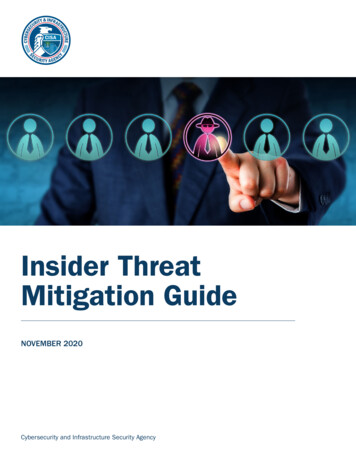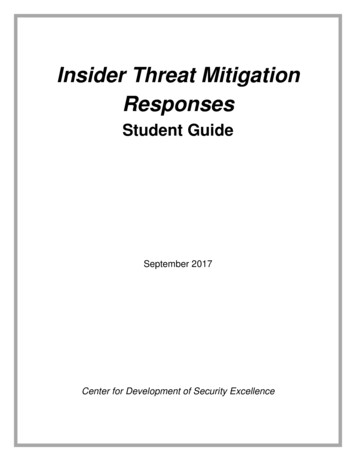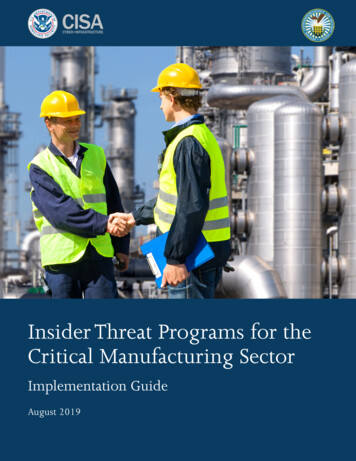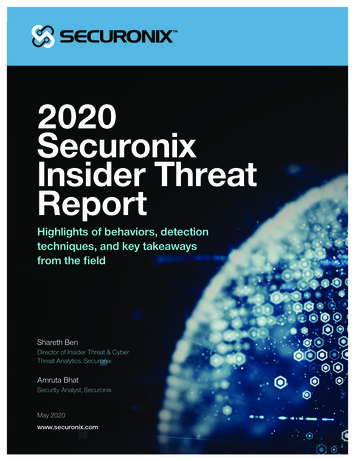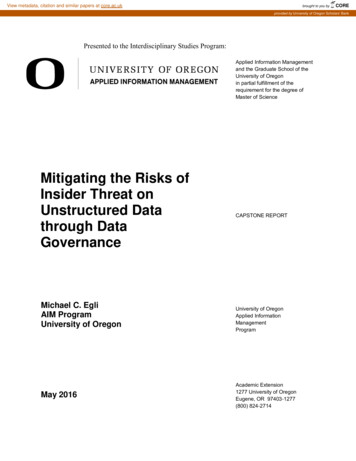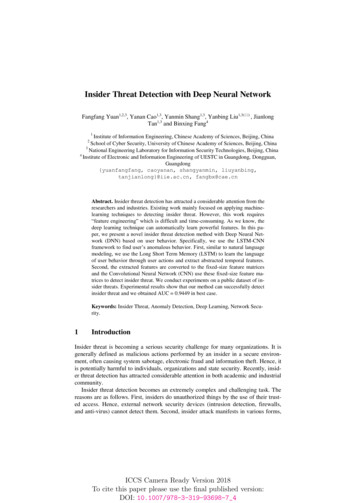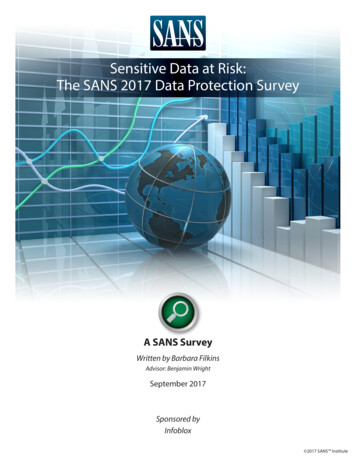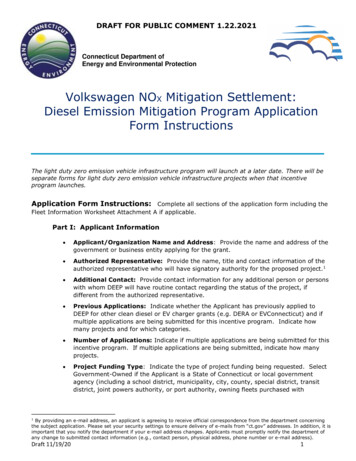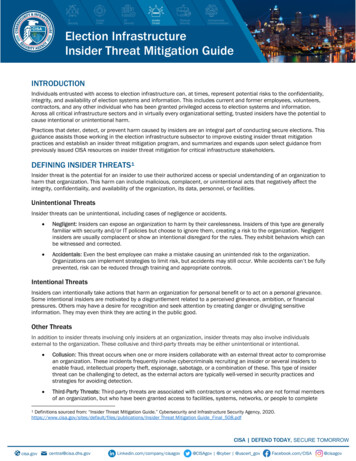
Transcription
Election InfrastructureInsider Threat Mitigation GuideINTRODUCTIONIndividuals entrusted with access to election infrastructure can, at times, represent potential risks to the confidentiality,integrity, and availability of election systems and information. This includes current and former employees, volunteers,contractors, and any other individual who has been granted privileged access to election systems and information.Across all critical infrastructure sectors and in virtually every organizational setting, trusted insiders have the potential tocause intentional or unintentional harm.Practices that deter, detect, or prevent harm caused by insiders are an integral part of conducting secure elections. Thisguidance assists those working in the election infrastructure subsector to improve existing insider threat mitigationpractices and establish an insider threat mitigation program, and summarizes and expands upon select guidance frompreviously issued CISA resources on insider threat mitigation for critical infrastructure stakeholders.DEFINING INSIDER THREATS1Insider threat is the potential for an insider to use their authorized access or special understanding of an organization toharm that organization. This harm can include malicious, complacent, or unintentional acts that negatively affect theintegrity, confidentiality, and availability of the organization, its data, personnel, or facilities.Unintentional ThreatsInsider threats can be unintentional, including cases of negligence or accidents. Negligent: Insiders can expose an organization to harm by their carelessness. Insiders of this type are generallyfamiliar with security and/or IT policies but choose to ignore them, creating a risk to the organization. Negligentinsiders are usually complacent or show an intentional disregard for the rules. They exhibit behaviors which canbe witnessed and corrected. Accidentals: Even the best employee can make a mistake causing an unintended risk to the organization.Organizations can implement strategies to limit risk, but accidents may still occur. While accidents can’t be fullyprevented, risk can be reduced through training and appropriate controls.Intentional ThreatsInsiders can intentionally take actions that harm an organization for personal benefit or to act on a personal grievance.Some intentional insiders are motivated by a disgruntlement related to a perceived grievance, ambition, or financialpressures. Others may have a desire for recognition and seek attention by creating danger or divulging sensitiveinformation. They may even think they are acting in the public good.Other ThreatsIn addition to insider threats involving only insiders at an organization, insider threats may also involve individualsexternal to the organization. These collusive and third-party threats may be either unintentional or intentional. Collusion: This threat occurs when one or more insiders collaborate with an external threat actor to compromisean organization. These incidents frequently involve cybercriminals recruiting an insider or several insiders toenable fraud, intellectual property theft, espionage, sabotage, or a combination of these. This type of insiderthreat can be challenging to detect, as the external actors are typically well-versed in security practices andstrategies for avoiding detection. Third-Party Threats: Third-party threats are associated with contractors or vendors who are not formal membersof an organization, but who have been granted access to facilities, systems, networks, or people to completeDefinitions sourced from: “Insider Threat Mitigation Guide.” Cybersecurity and Infrastructure Security Agency, ications/Insider Threat Mitigation Guide Final 508.pdf1CISA DEFEND TODAY, SECURE ompany/cisagov@CISAgov @cyber @uscert govFacebook.com/CISA@cisagov
Election Infrastructure Insider Threat Mitigation GuideCommercial Routing Assistancetheir work. This type of threat can involve collusion among multiple third-party entities. Third-party threats maybe direct, where specific individuals compromise a targeted organization, or indirect, where there may be flawsor outdated systems exposing the organization to unintentional or malicious threat actors.Examples of Unintentional Threats Allowing someone to “piggyback” through asecure entry point Misplacing or losing portable storagedevices or media containing sensitiveinformation Ignoring messages to install new softwareupdates or security patches Mistyping an email address andaccidentally sending a sensitive businessdocument externally Unknowingly or inadvertently clicking on ahyperlink or phishing email Improperly disposing of sensitivedocuments or dataExamples of Intentional Threats Attempting to alter or destroy ballots, mailin ballot envelopes, registration forms, orother core election documents Attempting to violate ballot secrecy Attempting to alter or destroy electionsdata, including voter registration data Allowing an unauthorized person to accesselection equipment, systems, assets, ordata Turning off security cameras or accesscontrol systems Stealing election equipment or data Leaking confidential information to thepress or public Intimidating or threatening other staffExpressions of Insider ThreatInsider threats manifest in various ways, including violence, espionage, sabotage, theft, and cybersecurity incidents. Cybersecurity Incidents: These include a range of actions, which may include theft, espionage, violence, orsabotage, dealing with anything related to technology, virtual reality, computers, devices, or the internet. Theseactions are undertaken using a variety of vectors such as viruses, data breaches, denial of service attacks,malware, or unpatched software, and can be either unintentional or intentional. Violence: An act of violence, threats of violence, or other threatening behavior that creates an intimidating,hostile, or abusive environment. Insider violence includes criminal or destructive threats, which precede aphysical attack, and damage infrastructure or harm the health and safety of an individual or organization. Thiscan include terrorism or workplace/organizational violence. Espionage: The practice of spying on a foreign government, organization, entity, or person to covertly or illicitlyobtain confidential or sensitive information for military, political, strategic, or financial gain. This includescriminal, economic, or government espionage. Sabotage: Involves deliberate actions aimed at harming an organization’s physical or virtual infrastructure,including noncompliance with maintenance or IT procedures, contamination of clean spaces, physicallydamaging facilities, or modifying or deleting code to disrupt operations. Theft: Theft involves multiple types of stealing, most often involving finance or intellectual property. Financialcrime is the unauthorized taking or illicit use of a person’s, business’, or organization’s money or property withthe intent to benefit from it. Theft also includes intellectual property theft, or the robbery of an individual’s ororganization’s ideas, inventions, and/or creative expressions. Digital systems containing large quantities ofcustomer data or intellectual property may be more appealing to bad actors.CISA DEFEND TODAY, SECURE TOMORROW cisagov@CISAgov @cyber @uscert govFacebook.com/CISA@cisagov
Election Infrastructure Insider Threat Mitigation GuideCommercial Routing AssistanceInsider Threats and Mis-, Dis-, and MalinformationWHAT IS MDM?CISA uses the following definitions for mis-,dis-, and malinformation (MDM). MDM canoriginate from both foreign and domesticsources. Misinformation is false, but not created orshared with the intention of causing harm.Disinformation is deliberately created tomislead, harm, or manipulate a person,social group, organization, or country.Malinformation is based on fact, but usedout of context to mislead, harm, ormanipulate.The information environment surrounding elections, andparticularly the spread of election-related mis-, dis-, andmalinformation (MDM), may provide additional motivation forinsider threats. MDM content is often designed to elicit astrong emotional response from the consumer and bypasslogical reasoning to incite action, whether the action is simplyspreading the content further on social media or taking actionin the real world, including acts or threats of violence. Acommon tactic deployed by both foreign and domestic MDMactors is to reinforce a strong sense of belonging, community,and in-group mentality among those who regularly consumetheir content. In instances where an individual already has agrievance with an organization or is experiencing otherstressors in their life, MDM narratives may provide analternate interpretation of reality that appears preferable toreal life. This vulnerability can lead to or exacerbate insiderthreats.While election infrastructure stakeholders cannot predict orfully control the information environment around elections,they can educate their staff, volunteers, and vendors aboutMDM narratives and tactics. Ongoing training and educationopportunities are especially important for non-full-time staff, who may not join the organization with full knowledge ofelection processes or how they may be impacted by MDM content. Similarly, election infrastructure stakeholders canmitigate the impact of MDM narratives through proactive and consistent communication with the public about electionprocesses. Such communication can help avoid fueling MDM narratives and build organizational resilience against them.When communicating about election processes, election infrastructure stakeholders should aim to providestraightforward, concise information without being overly detailed or causing more confusion.The current MDM environment, at the local, national, and international level, should be considered when assessinginsider threats. Transparent communication, in conjunction with the prevention and detection measures describedbelow, can help staff understand and perform their role, connect it to the organization’s mission to administer secureelections, and stay resilient against potential MDM narratives that undermine that mission and potentially incite insidersto cause intentional harm.BUILDING AN INSIDER THREAT MITIGATION PROGRAMElection officials and their private sector partners regularly employ practices designed to deter, detect, or preventharmful acts by insiders -- whether or not they use the term “insider threat” or have articulated their approach andpractices in a documented program. From handling ballots in teams of two, to robust chain-of-custody procedures, to thepresence of observers during voting and counting, many longstanding core election practices have been designed withinsider threat mitigation in mind. Nevertheless, election infrastructure stakeholders may benefit from documenting theirapproach and establishing a more formalized insider threat mitigation program. Such actions can help identify gaps incurrent practices and inform the organization’s broader approach to risk management.Successful insider threat mitigation programs employ proven practices, strategies, and systems that limit and trackaccess across organizational functions, services, and applications. Those practices and systems limit the amount ofdamage an insider can do, whether the act is intentional or unintentional. A holistic, multi-layered approach to insiderthreat mitigation combines physical and digital security with personnel engagement. An effective mitigation programaims to understand the insider’s interaction within an organization, track the interaction as appropriate and permitted bylaw, and intervene if the interaction poses a threat to the organization. An organization’s insider threat mitigationprogram is an essential component of the broader organizational risk management plan.A strong foundation for insider threat prevention and mitigation comes from a set of values that are shared and actedupon by everyone in the organization. Organizations should promote a positive climate of accountability, transparency,and trust. Organizational culture should also reinforce employee reporting as a core component of securing theenvironment.CISA DEFEND TODAY, SECURE TOMORROW cisagov@CISAgov @cyber @uscert govFacebook.com/CISA@cisagov
Election Infrastructure Insider Threat Mitigation GuideCommercial Routing AssistanceKey Elements of Election Infrastructure Insider Threat Mitigation ProgramsFrom a foundation of a proactive and supportive culture, election infrastructure stakeholders can implement severalproactive and preventive measures to reduce the risk and impact of insider threat activity. While each aspect isindividually important, they are most effective when implemented together to create a comprehensive, resilient electionadministration environment. Key elements of election infrastructure insider threat mitigation programs include:establishing robust standard operating procedures (SOPs), managing physical and digital access control, deploying zerotrust security principles, and implementing chain of custody processes.Establishes astandardizedbaseline forelection roles andresponsibilitiesGrants only thephysical anddigital accessnecessary for olChain ofCustodyZero TrustSecurityProvides anauditable record ofasset or datatransfers andtransactionsExplicitly verifiesevery request foraccess to systemsor dataStandard Operating ProceduresEstablishing and implementing SOPs primarily helps prevent unintentional insider threats due to negligence oraccidents. SOPs outline how organizational functions should be performed and standardize the various tasks andresponsibilities associated with different roles, increasing the quality and consistency of work across staff. Especially inan election environment, where volunteers and third-party vendors turnover regularly, SOPs can help employees onboardquickly, understand the expectations of their role, and successfully perform their duties. Further, SOPs create a baselineagainst which to measure outcomes and identify areas for increased efficiency and improvement.SOPs for each role or responsibility should clearly document the steps needed to perform the activity successfully. Thisincludes providing sequential steps for task completion, showing visuals and examples, and specifying the checklistsand logs necessary for verification. Incomplete or nonexistent SOPs may cause staff to develop their own procedures,which may induce additional risk. SOPs therefore limit ad hoc decision making and can help speed the remediationprocess should issues arise.Access ControlPhysical and digital access control systems both prevent and detect insider threats. Physical access controls may includelimiting access to facilities, equipment, devices, tamper-evident seals and bags, and other assets as well as providingvideo surveillance of physical assets. Digital access controls grant access only to necessary systems, assets, data, orapplications related to an individual’s job or function. In both cases, access logs, control forms, and surveillance videoprovide auditable records of who accessed a physical or digital asset, as well as when it was accessed. Overall, accesscontrol systems prevent any one individual from gaining entry to all assets within an organization, reducing potentialharm to physical or digital systems. If an incident is suspected, access logs and controls forms can help identify who isresponsible for potentially harmful behavior.CISA DEFEND TODAY, SECURE TOMORROW cisagov@CISAgov @cyber @uscert govFacebook.com/CISA@cisagov
Election Infrastructure Insider Threat Mitigation GuideCommercial Routing AssistanceAccess control systems should apply the principle of leastprivileged access to grant all individuals (full-time staff,volunteers, and vendors) access only to systems and datarequired to perform their essential functions. Access privilegesmay change leading up to an election or other key dates.Additionally, organizations should ensure that access is promptlyrevoked when an individual concludes their work or leaves theorganization (e.g., turning off facility access for vendors once theycomplete routine maintenance).A key challenge around access control forelection officials is access to the state voterregistration database system. The state maynot know who has access within each localelection office, so it is important forjurisdictions and state offices to work togetherto regularly confirm and update a list ofauthorized users and associated privileges.Zero Trust Security PrinciplesA zero trust approach to security is based on the principle of “always verify.” Instead of assuming that everything thathappens on an organization’s networks and systems is safe, the zero trust approach assumes that a breach has or willoccur and verifies each request as though it is unauthorized. Previously, in many organizations, the security of digitalassets was closely tied to the physical location where they were stored and universal trust in all members of theorganization. In other words, all devices in an office and all staff users could access most information, systems, anddata. This implicit trust of devices or users made it easy for insider threats to manifest in an organization undetected. Incontrast, the zero trust approach explicitly verifies every request for access, regardless of where it originates or whatresource it accesses. Many digital systems now include zero trustsecurity features that can be turned on, such as always requiringVisit https://zerotrust.cyber.gov/ forusers to enter their password rather than storing it in the device’sadditional guidance on zero trustmemory. Election infrastructure stakeholders may also considerimplementation from CISA and the Office ofprocedures like implementing the “two-person rule” (require at leastManagement and Budget (OMB).one observer to be present) or working in bipartisan teams whenaccessing sensitive resources.Chain of CustodyChain of custody is a transparent process to track the movement and control of physical and digital assets bydocumenting each person and organization that handled an asset, sensitive equipment, or data; the date and time itwas collected, transported, or transferred; and why the asset was handled. While not unique to elections, chain ofcustody plays a vital role in ensuring the integrity of an election and providing evidence in the event an insider threat isdetected, as well as improving remediation time if an incident occurs. Without robust chain of custody practices, electionsystems equipment, assets, or data at rest or in transit could be unknowingly accessed and manipulated by threatactors.Elections are complex, and there are many functions that make upthe intricate process of conducting an election. At every point wheredata, media, or equipment are entered, accessed, transferred,transmitted, or stored, there is an opportunity for error or risk. Robustchain of custody practices reduce this risk by creating an auditabletrail of assets throughout the election process.To address risk and improve security and resilience, electioninfrastructure stakeholders can utilize the National Institute ofStandards and Technology (NIST) Cybersecurity Framework (CSF) toestablish chain of custody standards, guidelines, and practices. NISToutlines a five-step process to identify assets and risks, protectsystems, detect incidents, respond to breaches, and recover.Example: a chain of custody procedurecould require that at least two people signall equipment, transported materials, ormedia access logs: the primary user and awitness who ensures the equipment, ,media, or other assets were appropriatelyhandled. Absent this requirement, it may bedifficult to verify who accessed ortransported the equipment, media, or otherassets and for what purpose.Establishing and maintaining necessary standard operating procedures, access controls, zero trust security, and chain ofcustody procedures are necessary facets of election administration. Further, they must be reviewed, tested, and auditedbefore, during, and after elections. Altogether, these measures support the integrity, reliability, and security of anelection, providing the evidence to build public confidence in the process.CISA DEFEND TODAY, SECURE TOMORROW cisagov@CISAgov @cyber @uscert govFacebook.com/CISA@cisagov
Election Infrastructure Insider Threat Mitigation GuideCommercial Routing AssistanceELECTION INSIDER THREATS IN FOCUSIn most jurisdictions, election officials administer elections with assistance from temporary or seasonal staff,volunteers, vendors, and contractors. Similar to potential threats posed by full-time staff, such individuals may posean insider threat. Therefore, election officials should ensure that all individuals involved in elections are considered,based on their specific roles and responsibilities, when developing an insider threat mitigation program.Vendors and ContractorsVendors and contractors should be held to the same level of security standards as employees. Election officialsshould ensure that they build into their procurement processes and contracting requirements the same safeguardsthat they hold their own employees to. When acquiring new contracted services, security requirements andminimum qualifications should be built into requests for proposals and in the final contractual agreements, such asmandatory background checks for all individuals who will be working on the contract.Vendors and contractors will likely have the same or greater physical and/or digital access to certain critical datathat full-time staff do, and they therefore bring similar, if not increased, risk to election infrastructure. Electionofficials should consider restricting or eliminating remote access to election systems or assets by contractors,limiting access to only systems and data required to perform the contracted service, and when possible, having agovernment official present when contractors access critical systems or data (but at minimum always require thatat least two people are present). When possible, segregate vendor and contractor accounts from those of regularemployees and utilize devices managed by the organization to prohibit untrusted devices on the network. Considerproviding individuals with a colored lanyard, badge, vest, or similar item when they are working at governmentfacilities so it is easy for all to identify who should or should not be in secure areas.Temporary Staff, Seasonal Staff, and VolunteersMost election offices rely on temporary, seasonal, and/or volunteer workers to conduct polling operations, includingthe operation of election equipment and transporting sensitive media or election materials, process voterregistration forms, handle mail-in ballot request forms, manage mail-in ballots, and other election administrationtasks. Building a successful team of temporary and volunteer staff starts with the recruitment of individuals whounderstand the mission of the organization and possess a high degree of accountability for their role. Upon joiningthe organization, all new members should be required to sign a code of conduct that clearly articulates expectedbehavior and outlines consequences for violations.In addition to the considerations above, temporary staff and volunteers should be retrained on systems, data, andsecurity practices prior to every election. It is especially important to provide updated training on MDM trends,including MDM risks specific to the state or jurisdiction. Finally, SOPs and chain of custody procedures shouldinclude guidance for all role types, including temporary staff and volunteers. This may include use of the two-personrule, or control forms, which can be an effective measure for temporary staff and volunteers to check each other’swork, deter harmful behavior, and verify compliance.CISA DEFEND TODAY, SECURE TOMORROW cisagov@CISAgov @cyber @uscert govFacebook.com/CISA@cisagov
Election Infrastructure Insider Threat Mitigation GuideCommercial Routing AssistanceDETECTING AND IDENTIFYING INSIDER THREATSEven the most robust preventive and protective measures cannot fully eliminate the risk of intentional or unintentionalinsider threats. Therefore, it is important for election infrastructure stakeholders to routinely test and audit theirprocedures, which will aid in identifying procedural gaps and responding to evolving threats in elections. Threat detectiontakes place through both human review and technical tools that monitor for the presence of threat indicators.As those who perpetrate violence or steal data often share their plans or grievances with others before acting,coworkers, peers, friends, neighbors, family members, or casual observers are frequently positioned to have insight intoand awareness of predispositions, stressors, and behaviors of insiders who are considering malicious acts.Each individual has a baseline of behaviors and straying from their norm could be an indication that something aboutthem has fundamentally changed. Important to the process of identifying potential threat indicators is understandingthat behavior is what matters most, not the motivation. The presence of political, religious, ideological, financial, orrevenge-based motivations helps to understand what drives an individual to act, but the individual’s behavioralindicators are the key to determining whether they warrant additional consideration, monitoring, or assessment as apotential threat.Insider Threat Preventative Measures as Detection MechanismsPreventive measures against insider threats, including SOPs, access control systems, zero trust security, and chain ofcustody, also contribute to detecting and identifying threats by establishing transparent, auditable election systems andprocesses. However, effective detection via these measures requires human understanding and oversight to ensure theyare being applied appropriately and audited routinely to identify outliers for further investigation. Having preventivemeasures in place means little if they are not consistently used.Each measure can aid threat detection in the following ways: Standard Operating Procedures: SOPs and best practices provide a common baseline for a team to measureagainst and detect when best practices are not being followed. Access Control Systems: These systems generate access logs and security footage that can be reviewed toverify access to both physical and digital systems and detect if unauthorized access has occurred. Zero Trust Security: Like access control systems, zero trust security measures will provide a record of access todigital systems and data. By validating a user’s identity at every request for access, zero trust measures providegranular information about access. Chain of Custody: Chain of custody produces an auditable record of an asset’s transfers and transactions,enabling detection of a potential threat if there is a gap in the chain.Continuous MonitoringMonitoring for insider threats, as well as for any issues with the systems in place, should be continuous. This involves acombination of human and digital tools, underpinned by a strong organizational culture of proactive reporting. Allemployees have a part to play in the process to hold themselves and others accountable for following establishedprocedures. Through ongoing, proactive monitoring, even the most organized and well-resourced election office may findpractices that are outdated or not consistently followed, leaving the organization exposed to risk if not properlyaddressed. Finally, all procedures and practices, including any monitoring programs, should be regularly reviewed andupdated for compliance with applicable federal, state, and local laws.AuditingInternal audits of all election and business processes should be a routine part of election administration before, during,and after an election. Audits validate whether measures such as access control and chain of custody are functioningproperly, collecting and maintaining necessary data or equipment, and being used appropriately by staff. They alsoprovide the opportunity to review records (access logs, security footage, chain of custody forms, etc.) and identify anypotential gaps or areas for improvement. Audits should be used to look for evidence that demonstrates the effectivenessand durability of procedures, processes, systems, and training practices.CISA DEFEND TODAY, SECURE TOMORROW cisagov@CISAgov @cyber @uscert govFacebook.com/CISA@cisagov
Election Infrastructure Insider Threat Mitigation GuideCommercial Routing AssistanceElection infrastructure stakeholders are encouraged to identify a timeline for periodic audits that makes sense for theirworkflow and capacity; smaller and more frequent internal audits of different processes may be less disruptive than onemajor year-end audit. It is recommended to build audits into an organization’s SOPs. Election infrastructure stakeholdersshould not wait for external requests to perform audits of their systems and processes.TransparencyThe election process is transparent and open to public observation, which provides a unique strength compared to manyother critical infrastructure areas. Allowing the public to assist with and observe the election process can help illuminatepoints where the process is unclear and provide opportunities to make improvements. From the perspective of insiderthreats, public participation may result in detectin
CISA DEFEND TODAY, SECURE TOMORROW 2 Commercial Routing Assistance Election Infrastructure Insider Threat Mitigation Guide . Election officials and their private sector partners regularly employ practices designed to deter, detect, or prevent harmful acts by insiders -- whether or not they use the term "insider threat" or have .
